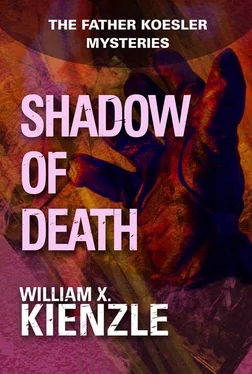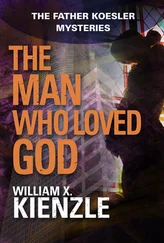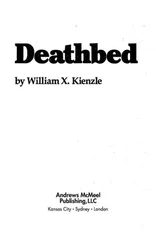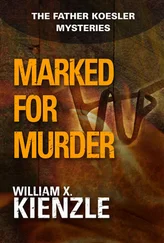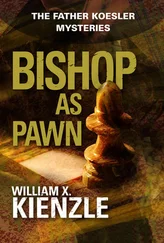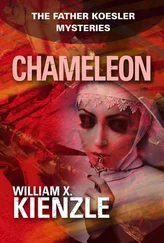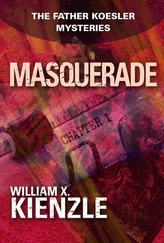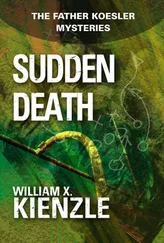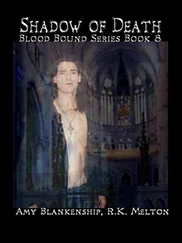But unexpectedly, there were two exceptions, both from Koesler’s pew.
First, Toussaint rose and quickly strode up the center aisle to stand beside Cardinal Boyle. The clergy surrounding Boyle would have prevented Toussaint from this approach except for two considerations. Few people ever remained in Toussaint’s path when he was going somewhere. One would have been as inclined to stand in the path of elephants enroute to their water hole. And secondly, Toussaint’s clerical garb provided him with entree.
When he reached the Cardinal, who had not known of Toussaint’s presence in Rome, Boyle greeted him warmly.
Toussaint was followed like a shadow by Koznicki, who had excused himself as he made his way around Koesler, then purposefully continued up the aisle. Koznicki, in turn, might not have been able to approach the Cardinal except that, like Toussaint, and for the same reason, people seldom deliberately attempted to block the Inspector’s trajectory. And, as he approached the Cardinal, Boyle motioned him to come closer.
So, as Cardinal Boyle turned to welcome the lines awaiting his blessing, he was flanked by Ramon Toussaint on one side and Walter Koznicki on the other. Koesler could not imagine a more dedicated brace of bodyguards.
As each person reached the head of the line, he or she knelt before the Cardinal, who gave his blessing and might or might not exchange a few words, depending on the initiative of the recipient.
The line shuffled and moved slowly, almost imperceptibly. Noise in the church was at a low decibel count. It consisted of shoes shuffling along the tile floor, people shifting in pews, soft speech, and whispers. All in all, it was mesmerizing. Koesler had all but drifted off into a light nap when . . .
. . . all hell broke loose.
It began with a startlingly loud shout. Instantly, Koesler was on his feet heading toward the front of the church. In this endeavor he had little luck because as those in the rear seemed to be trying to approach the altar, those in the front seemed to be trying to escape it. Thus, a pile of humanity gridlocked the center aisle.
Koesler’s height helped him see part of what was going on. As soon as he had heard the shout and stood, he saw Toussaint dive forward, taking someone to the floor with him. Not a second later, Koznicki followed Toussaint down.
Then, things became further jumbled. Several other people seemed to fall onto the squirming figures before the altar. Most likely they had been pushed on by those behind trying to see.
Pandemonium ensued. Women screamed, men shouted; most of the Detroiters tried to get closer to the action as most of the locals fought to get out.
Koesler noted that Joe Cox, Pat Lennon, and Irene Casey, who had been seated near the front of the church, had managed to get very close to the action. In fact, Koesler watched in bewilderment as Cox and Lennon were absorbed into the pileup. Irene undoubtedly would have suffered the same fate had not Cardinal Boyle stepped forward and assisted her up to the step next to himself.
Koesler looked every which way to find a passage to the altar. He spotted the by now familiar jumping-jack figure of the small round pastor clambering along the rear section of the center aisle headed for the narthex. Once out of the melee, the monsignor began leaping up and down again, and shouting, this time for the police.
They came soon enough, and promptly, like an icebreaker, began clearing a path to the altar. Koesler followed in their wake.
He hadn’t seen such a sight since the Super Bowl. And that had been via television, not on the spot.
Bodies were sprawled every which way. All one could see was arms and legs and heads and rumps, purses, hats, and shoes.
The police began righting people, starting at the top of the pile and moving downward. It reminded Koesler of a referee unstacking a pileup of football players to ascertain who has possession of the ball. From what he had seen, Koesler was positive that when the police got to the bottom of the pile, Toussaint would be on top of whomever was the cause of all this ruckus. And Koznicki would be on top of Toussaint. Koesler began to feel sorry for whomever was at the bottom of the pile.
The carabinieri peeled Cox off the pile. Making no move to smooth his rumpled jacket or pull his clothing together, he located his notepad and pen inside his jacket pocket and began taking notes. A reporter to the core.
Next up was the redoubtable Joan Blackford Hayes. Oddly, she seemed totally unmussed.
The police righted Lennon, who shook loose from their hands and began rearranging her clothing. “When I catch the sonofabitch who was pinching,” she addressed the still squirming pile, “I’m going to make some human pasta!”
Then the carabinieri reached Koznicki, the Inspector got to his knees as he displayed his identification. They stepped back and allowed him to assist Toussaint.
The deacon very slowly and cautiously raised himself from the man he was covering. “I would appreciate it. Inspector, if you would take the weapon.”
Koznicki painstakingly gripped the man’s wrist. His arm had been twisted behind him by Toussaint. Koznicki removed a vicious looking knife from the man’s hand. There was blood on the blade.
“Are you cut?” Koznicki asked anxiously.
“Just slightly, I think,” Toussaint replied.
Together the deacon and the Inspector lifted the man to his feet. Immediately, the Italian police handcuffed him. Koesler elbowed to his friends’ sides. “Ramon, you’re hurt!”
“It is not so much, Bob.” There were several gashes on the back of Toussaint’s right hand.
“We’ll get you to a hospital immediately.” Koznicki, using his pen and his handkerchief, tied a tourniquet around Toussaint’s arm.
Now that Toussaint had received first aid, all attention was focused on the assailant. He was a black man of moderate build, plainly dressed except for the scarf on his head. He had said nothing and appeared determined to say nothing.
“Another random attack?” Koesler’s sardonic question was addressed to Koznicki.
But it was Toussaint who answered. “I think not.” He jerked the scarf off the man’s head. Long black ringlets sprang free.
“Dreadlocks!” said Cox in awe.
“How did you know?” Koznicki asked.
“Partly intuition,” said Toussaint. “I was looking for someone. The scarf looked as if it was covering more than the ordinary amount of hair. But mostly it was his eyes.”
Koznicki looked intently into the man’s eyes, then nodded.
“His eyes are clouded,” Toussaint continued. “He has the appearance of someone under the influence of some chemical substance. Probably marijuana—ganja.”
“Wow!” was Cox’s contribution.
By this time, Lennon, too, was taking notes. Irene Casey stood nearby garnering details for her second-day story.
“Look!” said Koesler. He pointed to a small image on the floor where the scuffle had taken place.
“The black fist!” said Koznicki.
“Can someone tell me just what the hell is going on here?” As the words left Lennon’s mouth, she remembered where she was and immediately regretted the epithet. She caught a quick glimpse of Cardinal Boyle, still standing on the altar step looking concerned. She fervently hoped his preoccupation with what had just taken place precluded his being aware of her inappropriate language.
“In point of fact, yes, young lady,” said Koznicki. “I believe enough pieces have fallen into place so that we can tell you the story. But first,” he turned to the carabinieri, “someone see to this man’s wounds!”
8.
Even for Rome it was a tiny street, a cul-de-sac near the Aurelian Wall. And even though it was late Saturday night, very little was going on here. Every so often, a couple, arm-in-arm, would leave one of the flats, walk down the street, and disappear around the corner. Or a wage-earner would make his way home hurriedly. Or a wide, round wife and mother would stagger home under a load of groceries. At least the street itself was quiet.
Читать дальше
